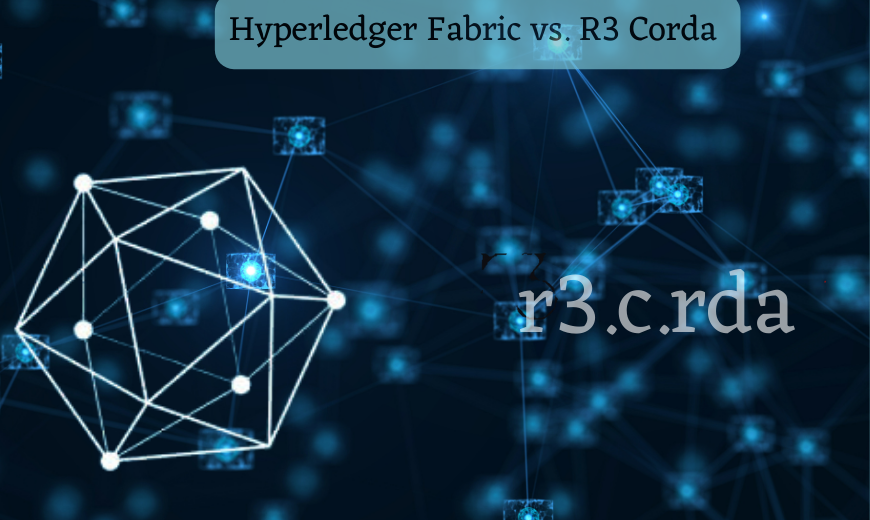
The curiosity in Enterprise Blockchain solutions has surged because traditional systems often suffer from data security threats. Data integrity, transparency, and interoperability are super important solutions for businesses worldwide. Regarding enterprise needs, Hyperledger Fabric and R3 Corda offer exceptional features for different business needs. This web blog highlights how Enterprise Blockchain addresses these security challenges. It stands out by providing practical solutions to improve various business environments. Blockchain offers a decentralized and immutable ledger to record transactions securely. This technology enhances community trust and strengthens operations by eliminating intermediaries.
But you already know this, don’t you? Well, if you don’t, make sure to check out our previous blogs on Enterprise Blockchain to familiarize yourself with the topics.
Selecting the right blockchain platform is necessary for businesses embarking on this space. Hyperledger fabric throughout different aspects. This comparison aims to help startups make a good choice for integration. Let’s compare their architecture, consensus mechanism, innovative contract capabilities, strengths, differences, etc. It helps businesses understand what to choose when selecting blockchain integration.
Let’s get straight into it.
The Linux Foundation
The Linux Foundation is a non-profit organization that supports Linux development and open-source projects. Hyperledger is its brainchild. Unlike other permissioned Blockchain platforms, which are driven by a single entity, the Linux Foundation is run by the community. Top tech companies and businesses come together to do the unthinkable in the Blockchain technology space.
An Overview of Hyperledger Fabric
Hyperledger Fabric is an open-source Blockchain framework developed under the Linux Foundation. It is known for its modular structure, flexibility, and development of applications or solutions. It motivates startups to build their own Blockchain solutions step by step. Before jumping into the details, let’s learn a little about the Linux Foundation.
Key Features of Hyperledger Fabric
- Modular Architecture: Hyper ledger Fabric’s modular architecture offers extensive customization. This modular approach lets enterprises selectively incorporate features that suit their different use cases, making the platform adaptable and expandable.
- Components: Hyperledger fabric stands out in flexibility by using pluggable modules for various processes. For example, organizations can pick different consensus mechanisms for them. It depends on their need for the final transaction and throughput. This adjustability assures that Hyperledger fabric can handle various business procedures.
- Applications & Use Cases: Unlike blockchain platforms with niche applications, Hyperledger fabric can handle general enterprise use cases. It sustains the execution of smart contracts called “Chaincode.” A chain code automates business logic across the network. Moreover, Hyperledger Fabric’s architecture has features like private channels for confidentiality. This kind of scalability is important for enterprise-grade integrations and deployments.
Hyperledger fabric’s modular architecture and focus on customization make it a favorite for startups. Businesses looking to deploy Blockchain technology safely into their operations can greatly benefit from it.
An Overview of R3 Corda
R3 Corda is also an open-source blockchain platform developed by R3, a prominent enterprise software firm. Unlike traditional Blockchain architecture, Corda is designed to address the privacy concerns of modern businesses. The financial services and trade finance sectors can especially benefit from it. Corda is a permissioned Blockchain because it shares data only with approved parties.
Critical features of R3 Corda
- Privacy & Confidentiality: One of Corda’s determining features is its strong privacy and confidentiality. It offers secure transactions and data sharing among users and participants without exposing sensitive data and information to the whole network. This feature is important for industries where data and privacy regulations are strict.
- Corda Nodes: Cord utilizes a unique architectural concept called “corda Nodes.” These nodes are designed to ensure the security of communications and data exchanges. They allow exclusive exchange between relevant entities involved in a transaction. This approach increases confidentiality and builds trust while maintaining the integrity of the entire Blockchain network.
- Finance and Trade: Financial and trade services are specifically for financial services and trade finance. Corda was initially incorporated with financial services in mind, but it has expanded beyond that. It is applicable to various industries needing secure and efficient transaction processing. Its architecture supports complex financial arrangements and workflows, which are done with the help of smart contracts called “CorDapps.”
While trade finance is the main focus for R3 Corda, it also has other uses:
- Loan origination and servicing
- Regulatory compliance
- Securities issuance and trading
- Know your Customer (KYC) processes
By focusing on priority and secure communication, R3 Corda creates a foundation in the financial sector. With its collaborative features, R3 Corda empowers these sectors to work together to create a secure environment.
A Head- To Head Comparison
There are two titans that stand tall in Enterprise Blockchain solutions: Hyperledger Fabric and R3 Corda. But how do you know which is the right fit for you? Well, it depends on your specific requirements. Let’s compare their features to help you choose your winner.
1. Architecture
- Hyperledger Fabric: Modular and versatile. Think Lego blocks – you choose components (e.g., consensus mechanisms) to build a custom solution. It is ideal for businesses with diverse needs and existing infrastructure to integrate with.
- R3 Corda: Purpose-built for the financial sector. It offers a pre-defined set of features focused on secure communication and privacy. Perfect for financial institutions seeking a ready-made solution for trade finance and other specific use cases.
2. Smart Contracts
- Hyperledger Fabrics: These use ” Chain code,” similar to smart contracts. However, Hyperledger Fabric offers more flexibility in the execution environment and programming language.
- R3 Corda: Uses flows” which are designed for financial transactions and highlight state management and data privacy.
3. Consensus Mechanism
- Hyperledger Fabric: It supports different consensus mechanisms, such as Practical Byzantine Fault Tolerance (IPBFT) and Kafka Byzantine Fault Tolerance (KBFT). This allows businesses to pick the one that most suits their requirements.
- R3 Corda: R3 Corda mainly uses a Byzantine Fault Tolerance (BFT) variant designed for its specific network architecture.
4. Security & Confidentiality
- Hyperledger Fabric presents some level of security through channels. Only authorized persons or participants are allowed to see the transactions on a specific channel. However, overall data privacy requires additional configuration.
- R3 Corda: It focuses heavily on privacy. Its “Corda nodes” concept ensures that only authorized parties involved in a transaction see the details, making it ideal for highly confidential business information.
5. Use Cases
- Hybrid Fabric: Because of its modularity, it is compatible with a wide range of industries. For example, I am responsible for supply chain management, trade finance, loyalty programs, and identity management.
R3 Corda: Primarily targets the financial services sector, specifically trade finance, loan origination, regulatory compliance, and KYC processes.
Choosing Your Champion
Need ultimate flexibility and customization? Hyperledger Fabric is your pick.
Prioritize privacy and confidentiality for financial transactions. R3 Corda is the clear winner.
Eventually, the best performance depends on your specific business requirements and priorities. Consider certain factors, such as the industry you operate in and the customization required, when making your choice. Also, the importance of data privacy should be kept in mind. Both Hyperledger Fabric and R3 Corda are amazing and powerful tools. Understand their pros and cons when choosing the one that suits your needs in the Blockchain space.
Wrapping Up!
So, in this web blog, we compared Hyperledger fabric and R3 Corda across different aspects. These aspects include architecture, consensus mechanisms, smart contracts, and more. Both of them are powerful contenders offering various features. By learning their strengths and weaknesses, startups can choose what’s best for them. Multiple factors should be kept in mind while making that decision. Customization, security, scalability, privacy, etc., are factors you should consider. As Blockchain technology advances, startups leverage these platforms to streamline business operations. Hyperledger Fabric and R3 Corda offer robust frameworks to drive creativity and efficiency in the digital space.
People Also Asked For:
Q.1. Which is better: Hyperledger Fabric or R3 Corda?
Ans: There’s no single “better” option – Hyperledger Fabric and R3 Corda are strong contenders in Enterprise blockchain. Here’s the key difference:
Hyperledger Fabric: Offers a modular architecture for customizable blockchain solutions across various industries. It is ideal for businesses seeking flexibility and control over their platform. (Keywords: Hyperledger Fabric, Modular, Customizable, Blockchain Solution)
R3 Corda: Designed specifically for the financial sector, focusing on privacy and secure communication. Perfect for financial institutions seeking a pre-built solution for trade finance and similar applications. (Keywords: R3 Corda, Financial Sector, Privacy, Secure Communication, Trade Finance)
Q.2. What are the critical differences between Hyperledger Fabric and R3 Corda?
Ans: Here’s a quick breakdown of the main distinctions:
Architecture: Fabric (modular) vs. Corda (purpose-built)
Consensus Mechanisms: Fabric (supports multiple) vs. Corda (primarily BFT variant)
Smart Contracts: Fabric (chain code) vs. Corda (flows, focus on state management)
Privacy: Fabric (requires configuration) vs. Corda (built-in focus on confidentiality)
Use Cases: Fabric (general-purpose) vs. Corda (financial services)
3. When should I choose Hyperledger Fabric vs. R3 Corda?
Ans: Consider these factors when making your choice:
Industry: Fabric for broader applications, Corda for finance.
Customization Needs: Fabric for flexibility, Corda for a pre-built solution.
Data Privacy: Corda is the top priority; fabric requires additional configuration.






